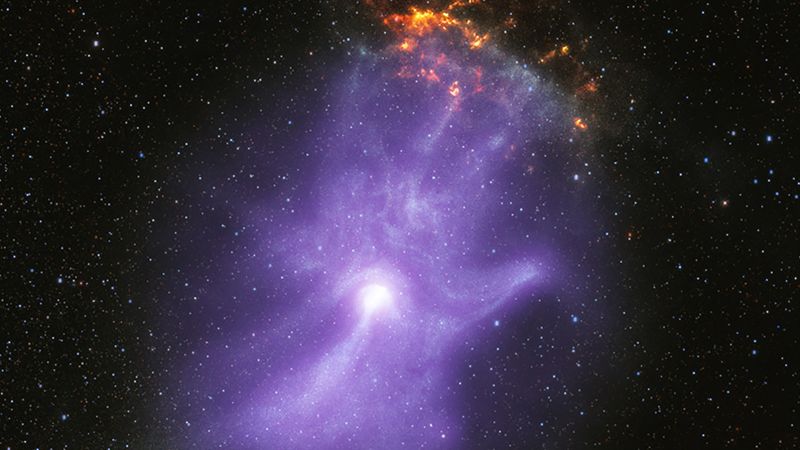NASA/CXC/Stanford Univ./R. Romani et al.
Data from NASA’s Chandra X-ray Observatory and the Imaging X-ray Polarimetry Explorer contributed to this composite image of a nebula that resembles a glowing hand.
Sign up for CNN’s Wonder Theory science newsletter. Explore the universe with news on fascinating discoveries, scientific advancements and more.
CNN —
The cosmos is brimming with enigmatic wonders, and Halloween adds an extra eerie touch to some of these mysteries.
NASA missions have recently captured some creepy celestial features, including a haunting “face” on Jupiter and a ghostly, skeletal hand-shaped nebula.
On September 7, during its 54th close flyby of Jupiter, the Juno mission observed swirling clouds and storms in the planet’s northern regions. The highly-dramatic image was captured by the JunoCam instrument as it orbited Jupiter and its largest moons since 2016.
NASA/JPL-Caltech/SwRI/MSSS/Vladimir Tarasov
JunoCam’s image of Jupiter reveals a swirl of atmospheric activity that resembles a face.
The image shows a Picasso-like face emerging from the turbulent atmosphere—a psychological phenomenon known as pareidolia, where observers perceive familiar objects or patterns in random stimuli.
The raw data captured by JunoCam is available to the public on the JunoCam website and was processed by citizen scientist Vladimir Tarasov. The low angle of sunlight during the close pass enhanced the image’s dramatic nature as Juno flew approximately 4,800 miles above Jupiter’s cloud tops.
X-ray technology, pioneered by physicist Wilhelm Röntgen in 1895, has now revealed the “bones” of a glowing hand-shaped cloud formed after the collapse of a star.
This nebula, known as MSH 15-52, originated 1,500 years ago when a massive star exhausted its nuclear fuel and collapsed. It currently resides 16,000 light-years away from Earth.
NASA/MSFC
Chandra’s original image of the nebula shows the pulsar, a bright white spot within the “palm,” while the orange cloud represents the remnants of a supernova explosion.
The collapse of the star gave rise to a dense remnant called a neutron star. Neutron stars that rotate rapidly and possess strong magnetic fields are known as pulsars. This particular nebula was created by the pulsar’s powerful winds and jets of energized material.
In 2001, NASA’s Chandra X-ray Observatory detected the bright pulsar, named PSR B1509-58, within the base of the hand-shaped nebula. The pulsar emits a jet that extends to the “wrist.”
More than two decades later, the Imaging X-ray Polarimetry Explorer (IXPE) observed the nebula for 17 days, marking its longest observing campaign since its launch in December 2021. The findings from the telescope’s operations were recently published in The Astrophysical Journal.
Lead study author Roger Romani, a professor of physics at Stanford University, stated, “The IXPE data provides us with the first magnetic field map of the ‘hand.’ The charged particles that produce the X-rays travel along the magnetic field, shaping the nebula much like bones do in a person’s hand.”
The unique observational capabilities of the IXPE telescope enable scientists to determine where particles in the nebula are accelerated by turbulent regions within the magnetic field.


